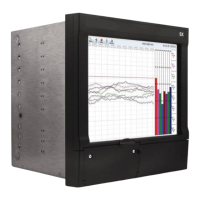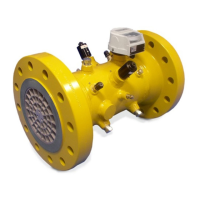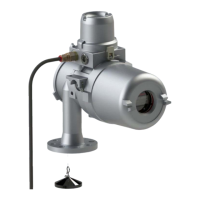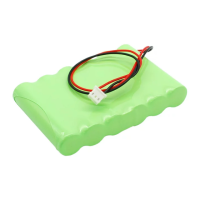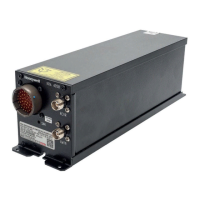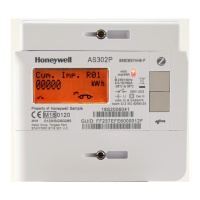26 Honeywell Sensing and Control
Signal Conditioning, Self Calibrating Digital Indicators
Rev. G, 008-0608-00
9.3.6 LIMIT.LATCHING Menu Item
This specifies whether to latch the activated limit so that only
manually clearing the limit will deactivate it. A latched limit can be
manually cleared by pressing the [CLEAR] button, sending the
“F8” serial communications command, or by using the Function
Input #2 (Clear Peak/Valley & Limits pin on the System Connector.
See “Function Input Pins” on page 18.
The options for this menu item are:
• “ON” means that once a signal activates the limit, the limit will
remain activated until it is reset.
• “OFF” means that the limit will deactivate immediately when
the signal crosses the return point.
9.3.7 LIMIT.CHANNEL Menu Item
This specifies the channel that is monitored by this limit.
9.3.8 LIMIT.SOURCE Menu Item
This designates the data source of the channel monitored by this
limit. Each channel has three data sources: the live tracking value
(TRACK), its highest value (PEAK), and its lowest value (VALLEY).
The options for this menu item are:
• “TRACK” means the live tracking value of the channel.
• “PEAK” means the highest value of the channel since the
peak/valley detector was last cleared.
• “VALLEY” means the lowest value of the channel since the
peak/valley detector was last cleared.
9.3.9 LEAVE MENU Menu Item
When the menu item is displayed, press [ENTER] to leave this
menu. Press [EXIT] to return to the RUN mode.
Chapter 10 Strain-Gage Input
Channel
10.1 Features
The Strain-Gage Input channel provides a dc excitation voltage
to and accepts millivolt signals from strain-gage transducers.
These millivolt signals are digitized, converted into engineering
units, and placed into the track, peak and valley data values of
the channel. Setup and calibration of the channel can be made
manually through the SETUP mode or automatically if the trans-
ducers are equipped with Signature Calibration. See “What is
Signature Calibration?” on page 3.
The analog-to-digital converter input circuit is ratiometric to the
excitation voltage, features adjustable digital, low-pass filtering,
12- to 18-bit resolution (depending on the filter setting) and has
several different mV/V input ranges. These many input ranges al-
low±50,000countresolution(attheslowestltersetting)across
a wide variety of mV/V input ranges.
Three methods of calibrating the Strain-Gage Input channel to the
transducer are available: known-load calibration, shunt calibra-
tion and mV/V calibration. The benefits of each are discussed in
“CALIBRATION TYPE Menu Item” on page 31.
Two rear panel control inputs can be field-configured for such
functions as remote tare, disabling peak/valley detection and
clearing the peak/valley values. A voltage or current digital-to-
analog output is also provided.
Many diagnostic functions are performed automatically to insure
correct wiring and operation of the transducer.
FP2000 Transducers
The Strain-Gage Input channel has its own internal shunt resis-
tor for use in Shunt Calibration. It is not compatible with FP2000
mV/V output transducers that are equipped with “Buffered Shunt
Calibration”. If you wish to use Shunt Calibration with an FP2000
transducer, use an FP2000 with Buffered Shunt cal and amplified
output (e.g. 5 Vdc, 10 Vdc or 4 mA to 20 mA) connected to an
SC’s High-Level Input channel.
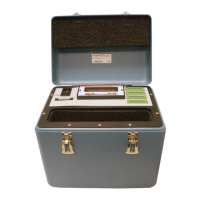
